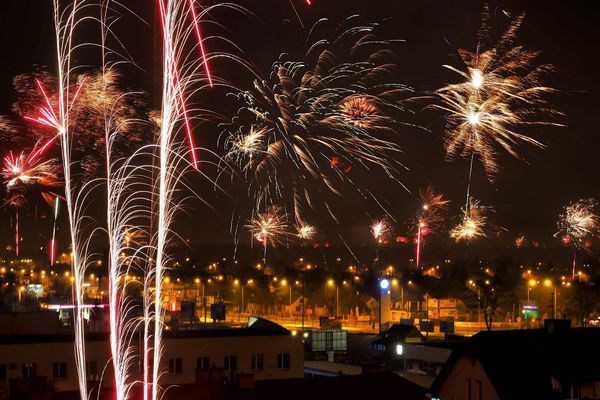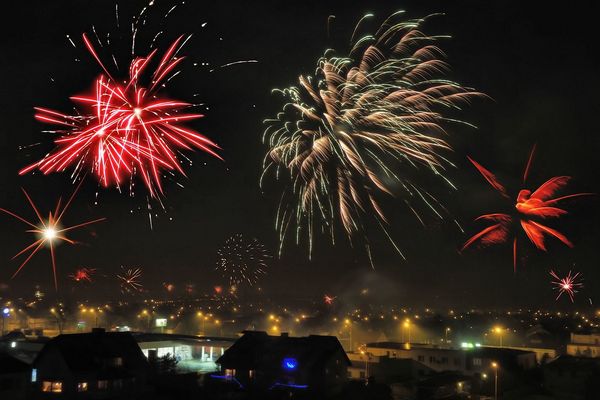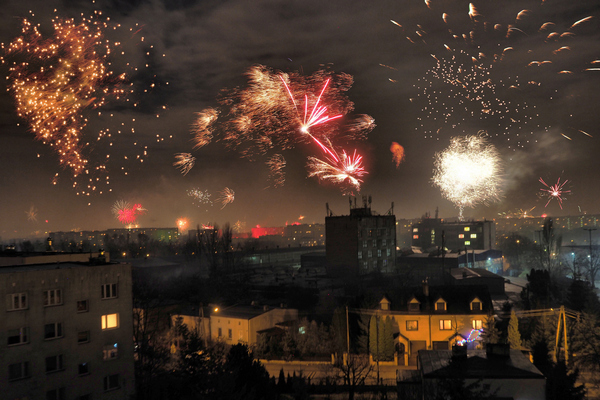
with articles on computer applications in photography.
|
Look, Ma, no Tripod! Shooting fireworks from hand |

|
Back to the Photo Bytes section, with articles on computer applications in photography. |
|
The general rule of shooting firework is: use a tripod. With recommended exposure times of four seconds or more, this makes perfect sense. (Refer to my old article on the subject elsewhere.)
Sometimes, however, you can't or won't use a tripod. You did not bring it along, or it would be awkward to set it up at a given spot, or you just don't feel like doing it (laziness should be considered a legitimate excuse). Good news: you can do without a tripod, and I'm not talking about using some steady support (like a car roof or a fence); I'm talking about the manly way of doing it: shooting from hand. The Exposure With digital cameras doing a good job in image stabilization, you can get away with exposure times as long as one or two seconds. For the E-M1 II using the (heavy but excellent) MZD 12-100/4.0 lens I've measured the success rate of 50% at 1 s for 12 mm and at 1/1.5 s at 100 mm. This means getting 50% of acceptably sharp frames at these shutter speeds. My definition of "acceptable" in those measurements was quite strict. The dark foreground with some light sources will accept more motion blur, so I would risk doubling the recommended exposure times, which would bring us to two seconds at the wide end. Just shoot more frames and pick the best. Camera shake blurs the stationary objects (buildings, trees, lights) but not the fireworks themselves, the latter being light trails rather than objects. The shake will make them wiggly, not blurry. Usually you will not even notice. Similarly, exposure time affects the brightness of stationary objects, but not that of firework trails; the former can be helped by using ISO 400; the latter is still just fine with that. The trails, however, will be affected: their number and length will, on average, decrease proportionally with the exposure length. We can do nothing about the length. This is why I would prefer to use exposures of two, not one second. For the number of bursts, the solution is quite simple: shoot multiple exposures of a scene, select ones with nice trails, copy those into one selected picture (the background image). More details on this — in the next section. For this to work, the fragments selected for copying should be just light trails on the background of dark sky. As they are largely unaffected by camera shake, for these "donor images" we could use longer exposures: four seconds, maybe even more, closing the aperture down by one or two stops. No need to align all pictures precisely: there in no foreground to match. Bingo: longer trails. Admission: I haven't yet tried the longer times for trail images, because this requires, for every frame shot, assigning it a function (background vs. donor) ahead of time. With exposures being the same, I can make that decision at the postprocessing stage, based on the amount of shake blur, or other factors. Postprocessing This can be done in almost any photo-editing application. The functions we need include the following:
The procedure to follow is quite simple:
New Year, 2018 This New Year night Agnieszka and I were celebrating it at our Polish home, with the seventh-floor balcony overlooking the vast expanses of city outskirts. We've been expecting some fireworks, and we've got'em. The problem is that it was well below freezing, not to mention windy, and I still have some survival instincts left. No way I'm going to set up a tripod and sit next to it for three hours, hoping for some good frames. This is good for the Fourth of July fireworks on Ocracoke Island, NC, but not here, in the middle of a Polish winter. So what I would do, was wait for some signs of activity, take a deep breath, run outside, where my wife was nourishing the Snow Queen side of her self, squeeze a dozen of frames, run inside, exhale. Rinse and repeat. The show was quite spectacular this year, at least that's what my wife says. She also says that the best of it was happening when I was inside. But how can I trust the testimony of someone who spent most of the time out there with her eyelids frozen shut? Agnieszka's memories of that night are, admittedly, quite different from mine. She says it was nice and warm outside, no wind, no drizzle — a perfect firework-watching night. That's not how I remember it. Anyway, here are some samples of what I got that night.
|
Just blind luck: somebody on the ground nearby launched a triplet when I was releasing the shutter. The exposure was two seconds, long enough to catch another seven or so fireworks (not counting a few more distant ones). this was, however, not enough.
With a tripod I could have used an exposure of four or even eight seconds, doubling or quadrupling the expected firework population; without, I resorted to borrowing from five other one-second frames, shot from the same spot and aiming in (approximately) the same direction. Not much different from one frame, exposed for eight consecutive seconds. Monochrome: nice, but just nice.
| 
40 mm, 2s at F/5.0, ISO 400
|
Here, the gas station and street lights behind make for a nice (if not too exciting) foreground. The white burst at the center is a part of the original frame (it was re-used in the first image, slightly rescaled).
The intense, reddish halo around the left firework looks OK in color, but way too bright after monochrome conversion (I'm using red filter). To fix this, I made a feathered selection around it, and applied two conversions: one with a green filter inside, and another, with red, outside. As there was some red spill in the sky nearby, that gets a bit too dark, which was handled by lifting the left end of the tonal curve.
| 
19 mm, 1 s at F/8.0, ISO 400
|
Even without any pyrotechnics added, the background picture is quite strong; post-apocalyptic, I would say. I would gladly see a non-firework version of it, and I will.
The composite uses six or so donor frames, and the end result is quite busy, perhaps too busy for my taste. Another variation adds a tad (in PSP v.20: 6%) of local tone mapping; strangely, I like it more this way. Finally, the monochrome version, with more LTM, is my favorite, it could be used as a backdrop in a horror movie. The two pink fireworks at the center were also used in the top image; to make that less obvious, I flipped them horizontally and enlarged a bit.
| 
17 mm, 2 s at F/5.0, ISO 400
| Final(?) thoughts So yes, with some persistence, luck, and postprocessing you can shoot fireworks from hand. Some purists will object, saying these are not "straight shots", but rather image manipulation. Really? A single eight-second exposure also captures a view consisting of fragments which were never seen in the scene at the same time. What if we close and re-open the shutter after each one second? And what if we insert a break after each one second exposure? At which moment does the picture lose its "straight" virginity? Does this happen when we decide to move the camera, even just a little bit, between those partial exposures? (This cannot be avoided when shooting from hand.) Or only when we zoom in or out between the frames? Or, on the other extreme, only when I bring in a firework from North Carolina and insert it into the Polish background? I am fairly permissive in this aspect. As long as all elements are from one location, one session, I consider this a fair game. That's what we really have seen there and then — just not all of it at one time. Good enough for me. | ||

|
Back to the Photo Bytes section, with articles on computer applications in photography. |
| Home: wrotniak.net | Search this site | Change font size |
| Posted 2018/07/01 | Copyright © 2018 by J. Andrzej Wrotniak |